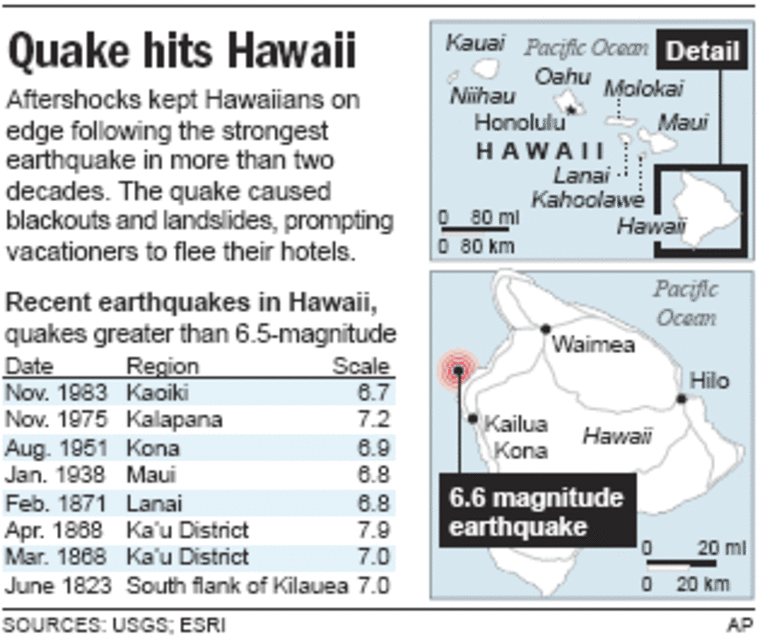The earthquake that jolted the Hawaiian Islands over the weekend set off one of the biggest FEMA deployments since Hurricane Katrina, including a planeload of about 100 federal experts who arrived here to find no catastrophe.
Nearly 14 months after the devastating hurricane, “forward-leaning” is the buzzword at the Federal Emergency Management Agency, which was harshly criticized for its flat-footed response to Katrina.
“If Katrina’s done anything, it’s given us a sense of ‘Go!”’ said Jeffrey D. Lusk, an earthquake specialist who led damage assessments along the northwestern coast of the island of Hawaii, known as the Big Island. “Err on the side of too much, too early, instead of not enough.”
Lusk’s team — accompanied by an Associated Press reporter — found little damage here from Sunday’s 6.7-magnitude quake. At a hospital near Kona, ceiling tiles fell onto surgical tables and water leaked from an overhead pipe, forcing the patients out. At Kawaihae Harbor, damage to piers shut the facility down and cut off the west side of the island to incoming goods through Tuesday afternoon.
Elsewhere, though, Environmental Protection Agency experts flown here Monday night on a government-leased jet found no spills that merited federal assistance. And locally based search-and-rescue and medical-response teams placed on alert by the federal government were never dispatched.
Teams on standby, just in case
Many of the workers brought in aboard the FEMA-chartered plane were kept on standby for tasks as mundane as driving vans and moving boxes. Among them were smokejumpers, the U.S. Forest Service firefighters who parachute into wildfires. Fires are not a problem here; the smokejumpers were brought along as a labor pool for tasks to be determined.
One FEMA official here estimated that bringing in the federal workers cost $400,000. Most of that — some $250,000 — represented the cost of leasing a jet that was parked in New York City when the quake struck. About 100 officials from across the federal bureaucracy were on the plane, and all needed housing and transportation once they got here.
FEMA officials rejected the notion that the response was an overreaction by a chastened agency.

“When you look at what happened in New Orleans, I don’t think you can put too much energy, resources — too much anything — into preventing that kind of catastrophe,” said Kim Walz, spokeswoman for the FEMA region that includes Hawaii.
“Everyone who works at FEMA would rather be overprepared that underprepared,” she said. “Personally, I think the American people would rather us be overprepared, too.”
It was 52 hours after the Sunday earthquake before the first members of the FEMA team flown in from the U.S. mainland reached the Big Island.
FEMA officials said that was because they wanted to assemble the whole team first, rather than allow members to converge separately on Hawaii and find themselves unable to communicate with each other. Also, FEMA officials said they had to wait for a Coast Guard cargo plane to take them on the last leg of the journey, from Honolulu to the Big Island.
Early damage assessments
FEMA has offices, warehouse space and a staff stationed permanently in Hawaii, and within two hours of the earthquake, its workers were doing preliminary damage surveys and firing up generators amid blackouts. Within six hours, a small team aboard a Coast Guard cargo plane reached the Big Island, near the quake’s epicenter.
A much broader federal effort was unfolding in Oakland, Calif., the headquarters for the FEMA region that includes Hawaii. With power knocked out across broad swaths of Oahu and phone service spotty, officials there began assembling a “go” team according to the guidelines of the National Response Plan.
The plan was issued in December 2004 as a blueprint for action during emergencies, and it dictates which federal agencies should be dispatched.
‘Err on the side of doing the right thing’
Bob Fenton, FEMA’s director of response for the region, had to make a series of decisions from his Oakland office, with little time or information. Should he lease the airplane and summon the federal experts? Should he place the search-and-rescue teams on alert? Should he ship 5,000 pounds of communications equipment on a military jet straight to the islands?
While Fenton’s supervisors might have occasionally second-guessed the costs of his big decisions in the past, a new message has come down, Fenton said: Be aggressive.
“Leadership has reinforced that ‘We want you to lean forward and make prudent decisions,”’ Fenton said. “’Err on the side of doing the right thing for the American people.”’
By the time the charter jet lifted off from Oakland Monday night, there were strong indications that Hawaii had not been devastated. The plane took off anyway, bearing experts from nearly a dozen agencies, including the Departments of Energy, Transportation, Agriculture and Health and Human Services.
The workers stayed at government expense in high-end Oahu hotels — about the only kind of hotel here — with reduced federal rates. For instance, many stayed at the Moana Sheraton Surfrider, steps from the beach in Waikiki, for $170 a night, compared with the usual rate of $228 the AP reporter was charged.